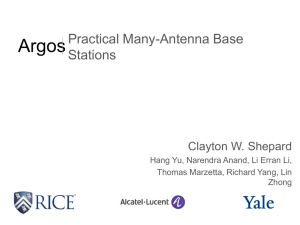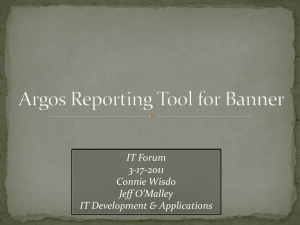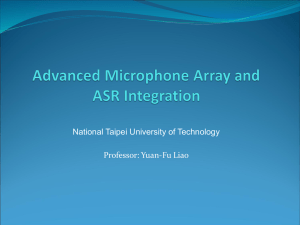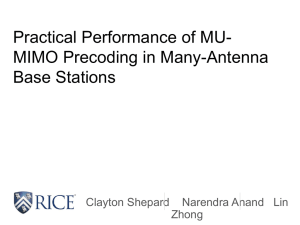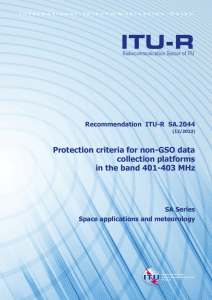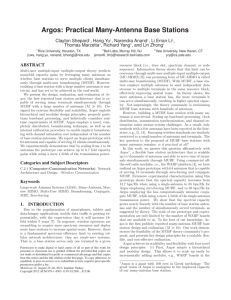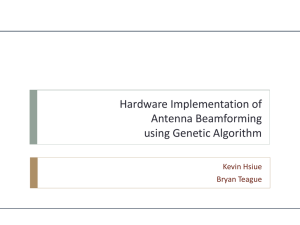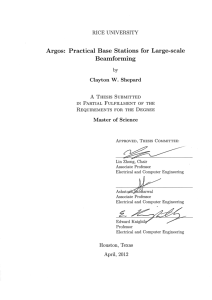slides - Argos
advertisement
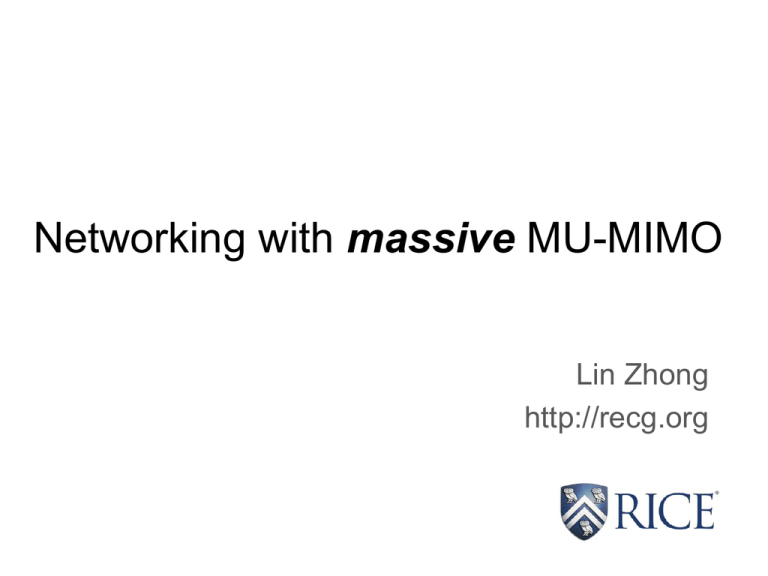
Networking with massive MU-MIMO Lin Zhong http://recg.org Guiding Principles • Spectrum is scarce • Hardware is cheap, and getting cheaper 2 Antennas 3 Omni-directional base station Poor spatial reuse; poor power efficiency; high inter-cell interference 4 Sectored base station Better spatial reuse; better power efficiency; high inter-cell interference 5 Single-user beamforming base station Better spatial reuse; best power efficiency; reduced inter-cell interference 6 Multi-user MIMO base station M: # of BS antennas K: # of clients (K ≤ M) Best spatial reuse; best power efficiency; reduced inter-cell interference 7 Key benefits of MU-MIMO • High spectral efficiency • High energy efficiency • Low inter-cell interference • Orthogonal to Small Cell solutions – Centralized vs. distributed antennas 8 Why massive? • More antennas Higher spectral efficiency • More antennas Higher energy efficiency • Simple baseband technique becomes effective T.L. Marzetta. Noncooperative cellular wireless with unlimited numbers of base station antennas. IEEE Trans. on Wireless Comm., 2010. 9 Background: Beamforming 10 Background: Beamforming Constructive Interference = 11 Background: Beamforming = Destructive Interference Constructive Interference = 12 Background: Beamforming = Constructive Interference Destructive Interference = 13 Background: Beamforming ? 14 Background: Channel Estimation Due PathtoEffects environment (Walls)and terminal Align For CSI uplink, isphases then send Uplink? aatpilot theBS from receiver at the the to mobility estimation has to occur A The pilot isthe sent fromcalculated each antenna terminal ensure terminal constructive and then sent calculate back interference to CSI theatBS BS quickly and periodically + BS + 15 Background: Multi-user MIMO BS H M: # of BS antennas K: # of clients K≤M 16 Multi-user MIMO: Precoding s s¢ = f (s) (Kx1 matrix) BS (M x 1 matrix) H M: # of BS antennas K: # of clients K≤M 17 Linear Precoding s s W s (Kx1 matrix) BS (M x 1 matrix) H M: # of BS antennas K: # of clients K≤M 18 Background: Zeroforcing Beamforming 19 Background: Zeroforcing Beamforming 20 Background: Zeroforcing Beamforming * -1 W = c × H (H H ) * T 21 Background: Conjugate Beamforming 22 With more antennas 23 With even more antennas 24 Conjugate Multi-user Beamforming W = c× H * Conjugate approaches Zeroforcing as M/K∞ Conjugate W = c× H * vs. Zeroforcing * -1 W = c × H (H H ) * T • Trivial computation • Nontrivial computation • Suboptimal capacity • Close to capacity achieving • Scalable • Not scalable 26 Recap 1) Estimate channels 2) Calculate weights 3) Apply linear precoding 27 Scalability Challenges 1) Estimate channels – M+K pilots, then M•K feedback 2) Calculate weights – O(M•K2), non-parallelizable, centralized data 3) Apply linear precoding – O(M•K), then O(M) data transport 28 Argos’ Solutions 1) Estimate channels O(M•K) → O(K) – New reciprocal calibration method 2) Calculate weights O(M•K2) → O(K) – Novel distributed beamforming method 3) Apply linear precoding O(M•K) → O(K) – Carefully designed scalable architecture C. Shepard et al. Argos: Practical many-antenna base stations. ACM MobiCom, 2012. Solution: Argos Architecture Data Backhaul Central Controller Argos Hub Module Argos Hub Module … Module Argos Hub Module Module … Module … Radio Radio … Radio 30 Argos Implementation WARP Module Ethernet Central Controller (PC with MATLAB) Central Controller Argos Hub Daughter FPGA WARP Module Cards WARP Module Daughter FPGA Radio Power PC Daughter Cards FPGA Cards 1 Radio Radio Argos Hub 1 Radio 2 1 Peripherals Hardware Radio FPGA Fabric Argos Ethernet Radio Argos and Other I/O Model Radio 2 FPGA Fabric Interconnect Module Interconnect 3 Peripherals Hardware 2 Radio Peripherals and Other I/O Hardware Model Radio Sync Pulse Module and Other I/O Model 3 Radio Clock Board 4 3 Radio Clock Radio Clock Board 4 Module Clock Board 4 Distribution … Power PC PowerFPGA PC Fabric 31 16 32 Central Controller WARP Module s Argos Interconnects Sync Distribution Argos Hub Clock Distribution Ethernet Switch33 Experimental Setup • Time Division Duplex (TDD) – Uplink and Downlink use the same band • Downlink Listen to pilot Send data Calculate BF weights 34 Conjugate vs. Zeroforcing 35 Without considering computation Listen to pilot Send data Calculate BF weights 36 Linear gains as # of BS antennas increases Capacity vs. M, with K = 15 37 Linear gains as # of users increases Capacity vs. K, with M = 64 38 Considering computation Listen to pilot Send data Calculate BF weights 39 M = 64 K = 15 Zeroforcing with various hardware configurations 40 Conclusion • First many-antenna beamforming platform – Demonstration of manyfold capacity increase • Devised novel techniques and architecture – Unlimited Scalability • Simplistic conjugate beamforming works • Need adaptive solutions 41 Ongoing work • Inter-cell interference management • Pilot contamination • Client grouping & scheduling ArgosBS 1 (Outdoor) 10 GbE 10 GbE 10 GbE Server NetFPGA Server NetFPGA 10 GbE ArgosBS 4 (Indoor) Server NetFPGA 10 GbE ArgosCloud 10 GbE 10 GbE ArgosBS 2 (Outdoor) ArgosBS 3 (Outdoor) A network of massive MU-MIMO base stations 42 43 ~$2,000 per antenna 44 Acknowledgments http://argos.rice.edu 45 More BS antennas + MU-MIMO Higher efficiency & lower interference More BS antennas + MU-MIMO Higher efficiency & lower interference
